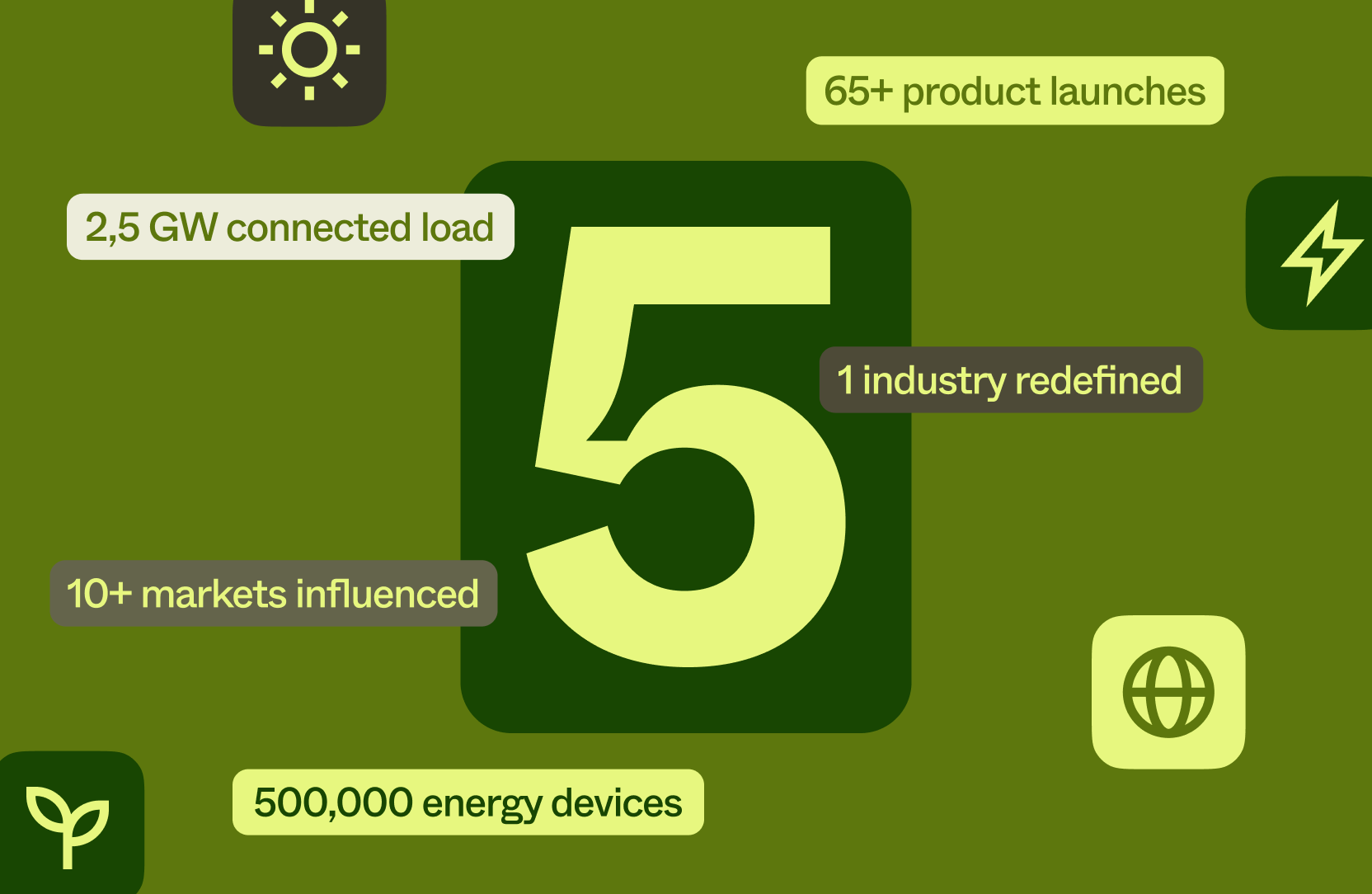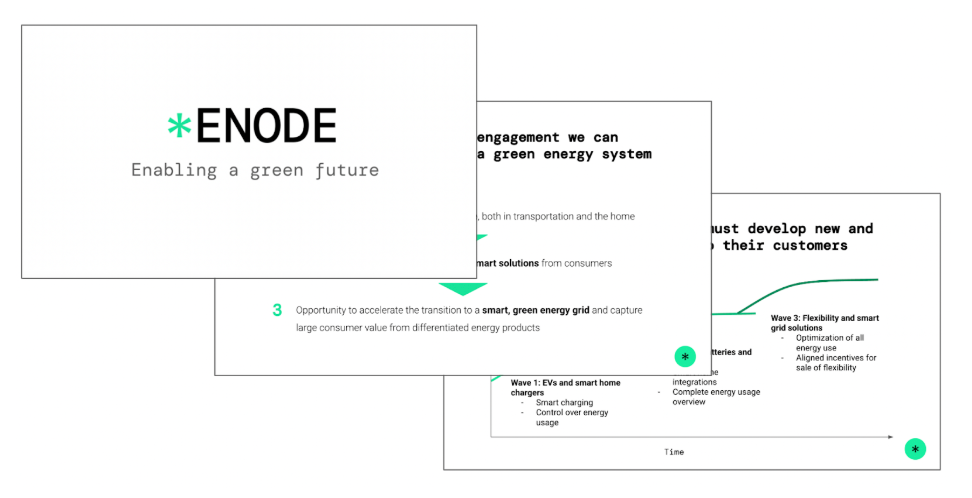Enode at five: building a company in an industry that’s still taking shape

Enode turns five this year. And five years in energy is a lifetime.
Since 2020, we’ve supported 65+ product launches, integrated over 500,000 energy devices, and connected 2.5GW of load. But those milestones don’t tell the full story. What’s harder to measure – but just as important – is what we’ve learned along the way.
When we started, APIs weren’t part of most energy retailers’ strategies. Consumer flexibility was a niche concept. And the idea that energy apps could become core infrastructure for the grid felt distant.
Today, that landscape has changed. And so have we.
This is a reflection on what it’s meant to build a company in a category that’s still taking shape. And what five years of navigating that uncertainty has taught us.
The industry isn’t stable – and that’s the opportunity
When we founded Enode in 2020, most energy retailers weren’t focused on consumer flexibility. Home energy management was early-stage, and very few connected products were live.
Five years later, flexibility is at the center of many go-to-market strategies. We’ve supported over 65 launches, and some of our partners are seeing real traction – especially in EVs, solar, and battery-based propositions. In the Nordics and the UK, these offerings are now mainstream. Other markets are quickly catching up.
At the same time, regulation has moved from playing catch-up to actively shaping the market. From the EU Data Act to FERC 2222 and Australia’s Open Energy reforms, policy is becoming part of the infrastructure.
And if you’re expecting things to slow down, they won’t. The energy transition is still early. The pace of change is increasing.
The companies doing well today are the ones that turn complexity into advantage – by adapting quickly, connecting more devices, and building systems that can handle uncertainty.
Education is crucial to build companies amid industry chaos
We didn’t just build a product. We built a company while the category itself was still forming.
That meant moving ahead of the market sometimes, and helping others find their footing at others. Flexibility is still new ground. There’s no clear playbook. Many players aren’t sure what they’re building toward at the start.
As Mari Landsem, CCO at Enode put it:
“Some of our most successful customers didn’t start with big ambitions. They began with a narrow use case – and expanded fast once the results were clear.”
That reflects something we’ve seen again and again: progress comes from clarity. Internally and externally.
Flexibility won’t scale without consumer participation. And participation starts with understanding. That’s why helping customers and users make sense of what’s changing has become as central to our work as the platform itself.
In this space, learning isn’t extra – it’s core to the job. And sharing that learning clearly and consistently is what moves the ecosystem forward.
What we’ve learned about building in energy
These lessons didn’t come from whiteboards. They came from five years of shipping, iterating, and working side-by-side with companies navigating the same uncertainty.
Lesson 1: Speed looks different here – but it still matters
In energy, speed isn’t about moving fast in the traditional sense. It’s about momentum.
We’ve seen flexibility products stall. Not because the idea was wrong, but because teams couldn’t align on where to go next. The pilots that succeed are the ones with a plan to scale. They involve product, ops, and trading from day one. They make decisions early, learn fast, and stay aligned on what success looks like, before the market defines it for them.
Speed here means shortening feedback loops, not sprinting to launch.
Lesson 2: Leadership is about making sense, not just decisions
There is no established playbook for flexibility. That means leadership isn’t just about making the right calls, it’s about helping others understand the landscape.
Whether you’re shaping policy, building a product, or setting strategy, clarity is the most valuable thing you can offer. It creates alignment. It accelerates trust. And it makes it easier for the entire ecosystem to move in the same direction.
We’ve learned that the best leaders in this space don’t just act. They help others see the why behind the what.
Lesson 3: Staying focused is the hardest – and most valuable – thing we’ve done
When everything is in flux, it’s easy to get distracted. We’ve seen too many promising products derailed by ploughing resources into building APIs rather than IP.
The best outcomes we’ve seen – for us and our partners – come from sticking to a clear vision and playing to your strengths. Most energy players want to build their own differentiated tech stack rather than plugging into someone else’s. And the best ones know what to build, and what to buy.
The flex products that have achieved the most success have retained ownership of their value chain, and doubled down on what makes them indispensable.
Lesson 4: Flexibility is personal. So is energy.
Energy is not abstract – it powers homes, cars, and lives.
That’s why flexibility can’t just be technically correct. It needs to be understandable, intuitive, and trustworthy. We’ve learned that the systems we build have to make sense to everyone involved: product teams, support teams, regulators – and ultimately, consumers.
Because participation doesn’t happen without trust. And flexibility doesn’t scale without participation.
Some things never change
The energy industry has changed dramatically in the past five years. So has Enode – just take a look at our early decks if you need proof of our glow up.

But the things that matter most haven’t changed at all. Our mission still holds: to accelerate the transition to a flexible, sustainable energy system. Our belief in openness, interoperability and reliability has only deepened. And the need for energy companies to differentiate – not just comply – remains an urgent priority.
In five years, our product, our scale, and our internal operations have all changed dramatically. Our conviction, our principles, and our ambition haven’t.
The pace of the energy transition isn’t changing, either. As it continues to evolve, our role is to keep showing up with clarity, repeatability, and the long view.
To everyone who’s helped shape our first five years – thank you. If you’re building in this space, or navigating its ambiguity, we’re right there with you.
The next five years will demand even more alignment, integration, and openness. We’re ready for it – not because we’ve figured everything out, but because we’ve learned how to keep learning.
